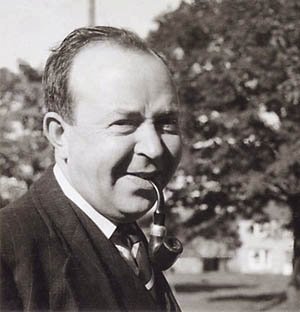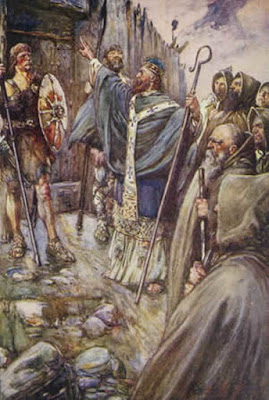The
following item was transcribed by Calum Maclean on the 7th of July 1952 from
the recitation of John MacDonald, a retired carpenter, then aged 77, from
Newtonmore, Badenoch. It is not too often that a tradition bearer gives an
overview of what he or she thinks about a particular subject – Highland
superstitions in this instance. It may be assumed that MacDonald had read a fair
bit of material about the subject area, one which by all appearances seemed to
have fascinated him:
Highlanders are addicted to superstition.
Perhaps the rugged nature of the country, its dreary wastes and rapid torrents
which thunder and lightning and the rains of heaven exhaust their terrific
rage, wrought on their imaginative powers and so they ascribed everything to
the superior powers. Be that as it may, I think so long as ignorance abounded
superstition did much more abound. So the world has grown older: the people
have grown wiser and the grosser. While saying this, it must be admitted that
some of the milder forms still find acceptance such as freits and omens:
“Marry in May and you'll rue it for age,” is
an old freit. And a dog howling at night it still believed to betoken a death
(B733.2.). Then there is the practice of first footing at the New Year time and
the throwing of an old boot after the bride. There is an old rhyme which
embraces a number of omens:
West wind to the
bairn;
When gang for its name;
Rain to the corpse
Carried to its long hame;
A bonnie blue sky
When gang for its name;
Rain to the corpse
Carried to its long hame;
A bonnie blue sky
To welcome the bride,
As she gangs to the kirk
with the sun on her side.
As she gangs to the kirk
with the sun on her side.
The belief in ghosts, witches, fairies etc.
was quite common at the beginning of this century. In fact the ghost stories of
Scotland would fill a large volume. Witches were the object of dread. They were
accused of having intercourse with Satan. It is said that the Black Officer of
Baile Chròdhann made bargains with the Evil One (M211.). It was believed that
the witch could cure diseases and inflict diseases (G265.4.), could draw
away every drop of milk (D2083.3.) from, the cattle. Only a horse-shoe
(D1561.1.3.) nailed to the byre door or a sprig of rowan tree tied with a red
thread was a protection (D1385.2.5.). It is popularly believed that
fairies inhabited mounds or eminences (F211.). One such eminence I am reminded
of near my own home called the ‘Sìdhean’ – probably taken from the word ‘sìdhich’.
It is believed that in Hallowe’en (F211.1.1.1.) any person going round
one of these hillocks nine times (Z71.6.) contrary to the course of the
sun (D1791.2.), a door would open (F211.1.1.) by which he would be
admitted to the realms of fairyland (F211.1.). The burning of witches
(G200.) forms a black chapter in the history of Scotland based, no doubt, in
the command given in the 22nd chapter of Exodus: “Thou shalt not suffer a witch to live.” Some
time ago I worked at Fortrose near the very spot where the Brahan Seer was
burned in a barrel of tar (S112.1.).
Closely related to superstition is the second
sight (D1825.1.). People believe that Nature bestows on some individuals
this gift called in Gaelic ‘taisiche’, a spectre or a vision – an impression
made either by the eye on the mind or the mind upon the eye. Seers are said to
see events before they happen such as funerals (D1825.7.1.), marriages etc. (D1825.7.).
I can recall one or two individuals who were said to have this faculty. Dr.
Johnson believed in the genuineness of this faculty. Highlanders are singularly
attached to their birthplace and that fondness is not confined to the desire of
living. It is extended even to the grave. The idea of dying at a distance and
among strangers could not be endured. To be consigned to the grave among
strangers was a great calamity. A story will illustrate. A few years ago an
aged woman went to visit a friend – her daughter – in Perth. She was from Laggan.
While there she took a slight chill and fever set in. One evening when a
quantity of snow fell – it had fallen during the night and she expressed great
anxiety when told that a fall was expected. Next morning her bed was found
empty and no trace of her could be discovered till the second day, when she sent
word that she had slipped out of the house about midnight, set off on foot
through the snow and never stopped till she arrived home – a distance of more
than twenty miles, her daughter went to see her. She said: “What if I grew
worse and if I had died they could not get my remains through the deep snow.
And if I had told my daughter she could have locked every door of the house. And
God forbid that my bones should lie at a distance from my own home.” To be
interred decently is a big consideration in the mind of the Highlander. In fact
every article is secured to assure a respectable interment – to put it in
Gaìdhlig “crìoch onarach.”
The narrator gives an overall view of some of the typical beliefs that used to held (and perhaps may yet be still held) by some Highlanders. Such superstitions are, however, by no means limited to a Gaelic wold view and can be found in many parts of the world.
Reference:
SSS NB 13, pp. 1118–22
Image:
Portrait
of Captain John MacPherson, the ‘infamous’ Black Officer. Courtesy of the Clan
MacPherson Museum, Newtonmore, Badenoch.







